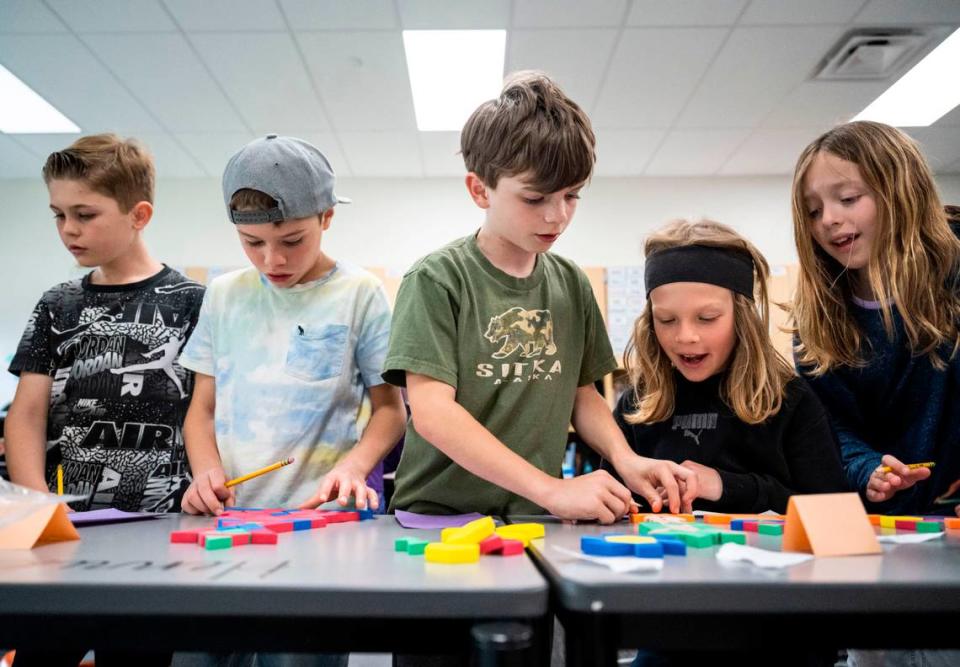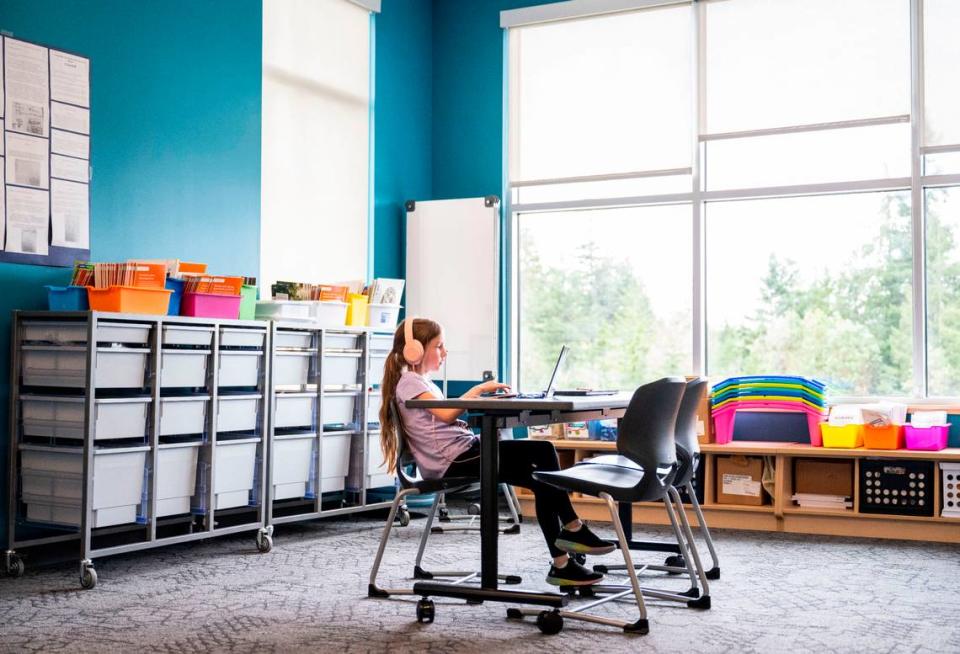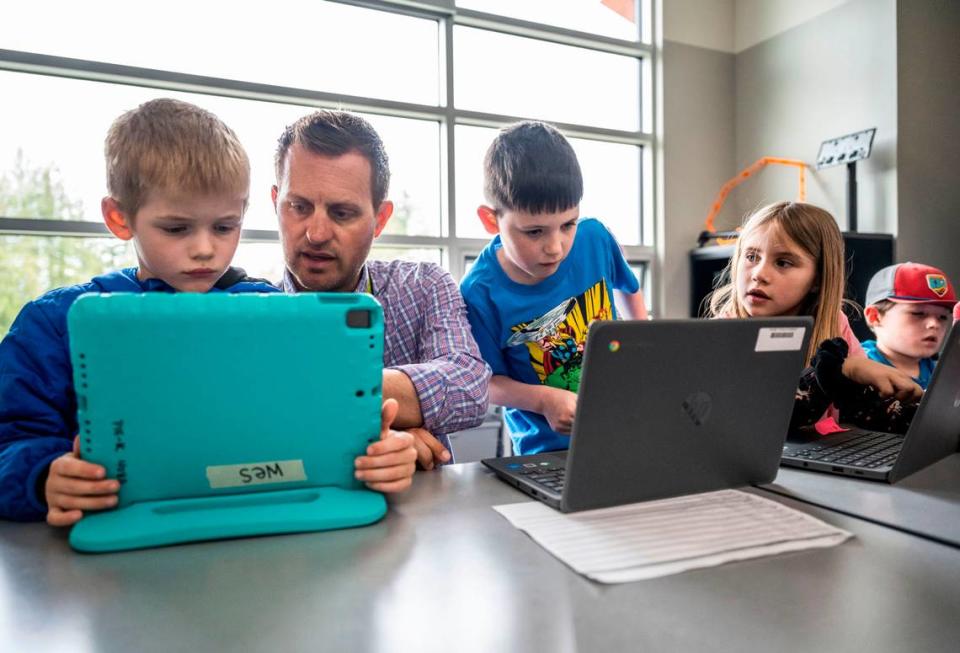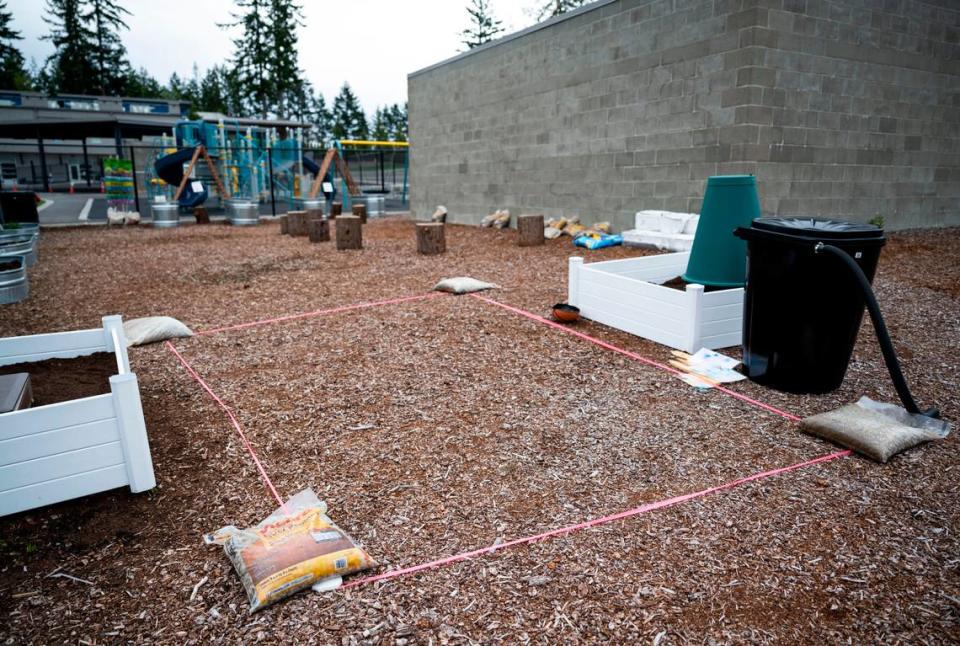This local school has a garden, a worm bin, cafeteria compost, and national recognition
Leftover cafeteria food makes its way to compost bins in Pioneer Elementary School’s student garden.
That’s just one element that led to Pioneer’s recognition as a Green Ribbon School by the U.S. Department of Education and the Washington Office of the Superintendent of Public Instruction (OSPI) in April.
Pioneer is one of two schools in Washington to be honored with the award and one of 26 schools chosen in the country.
Green Ribbon Schools are “reducing environmental impacts and costs, improving health and wellness, and offering effective sustainability education,” according to the OSPI news release April 21.
Pioneer is the only STEAM (science, technology, engineering, art, and mathematics) project-based learning school in the Peninsula School District. It has a lottery enrollment process, John Hellwich, assistant superintendent for the district, told the Gateway May 1.
Pioneer saw 259 students enter the lottery this year, mostly for their kindergarten openings. The school teachers kindergarten through fifth grade. It has 512 students.
Schools that apply for a Green Ribbon award need to meet the criteria of three different pillars to get it, Stephanie Strader, principal at Pioneer, told the Gateway May 1.
Reduce environmental impacts and costs
One of the pillars to be a Green Ribbon School is to reduce environmental impacts and costs.
Pioneer met this criteria with the sustainability of the building itself. The district remodeled the former Gig Harbor Boys and Girls Club to build the school in 2019, district spokesperson Danielle Chastaine said.
The new building has a mix of reusable and sustainable materials, she said.
The fourth- and fifth-grade wing, school gym and cafeteria were built from the old Boys and Girls Club. The floors and wood ceilings throughout the building also remained the same.
New additions include the school office, library, the kindergarten and first-grade hallway, and the second- and third-grade hallway. Windows and lighting were updated in the building to be more energy efficient.
Improve health and wellness
Another pillar to be a Green Ribbon School is to improve the health and wellness of schools, students and staff.
The Peninsula School District recently received a grant from the Washington Education Association to help promote wellness among staff with training on strategies to recognize burnout, positive boundaries and relaxation strategies.
Pioneer received about $800 of that grant. School leaders haven’t decided how they will use the money, but have been talking with Swiftwater Elementary about pickleball matches and other activities for staff.
Pioneer staff and students participate in conversations and workshops about ways to take care of themselves, emotionally and physically, Strader said.
She added that Pioneer teachers have conversations with students about physical activity, managing big emotions, making friends, and how to problem solve.
Environmental and sustainability education
The last pillar to be a Green Ribbon School is to provide effective environmental and sustainability education, incorporating STEM, civic skills and green career pathways.
As a project-based learning school, Pioneer teachers design their units to link reading, writing, and math around Washington’s next generation science standards, which means they teach subjects together.
For example, during an extreme weather unit students read articles about the different types of extreme weather. They practiced finding the main idea and key details of the article, which met reading standards.
Then they wrote a public service announcement about how to reduce the effects of extreme weather, which met writing standards for informational writing.
During math time, they looked at climate graphs and tables to find patterns in the data.
Strader said the integration separates Pioneer from other schools.
Jennifer Wisner, an innovation instructional coach at Pioneer, works with the teachers to create project-based learning (PBL) units.
“We start with our big question and then we look at what learning experiences will help kids answer that big question,” Wise said. “Each lesson will get them closer to an answer. Some days it could be exploring reading, a podcast or a video, and then a discussion on what they learned.”
Each grade completes about three PBL projects a year. Each project is six to eight weeks.
Pioneer uses a multi-age model, which means they combine grades together in the classrooms, Chastaine said.
Pioneer has three grade groups: kindergarten and first, second and third, and fourth and fifth.

Kindergarten and first-graders are in an animal adaptations unit. They’re answering the question: How do we use animal adaptations in our own lives?
“The kids will look at how animals have adaptations that help them survive in their habitats and that humans mimic those adaptations at times to solve problems,” Wise said.
She gave the example that flippers for scuba diving are like those of aquatic animals.
Second- and third-graders are in a survive and thrive unit. They’re answering the question: How can we help animals that have been impacted by environmental changes?
“These kids look at how animals and plant traits are influenced by their environments and how this helps with a species’ survival,” Wise said.
So far, they’ve learned about endangered species of bees and bats.
By June the second- and-third graders will have built a bird house, bat house or habitat. They’ll use what they’ve learned to determine a good spot to place it in their community.
Fourth- and fifth-graders are in an ecosystems unit. They’re answering the question: How do humans create and sustain a healthy ecosystem?
“Students will examine how energy is transferred in an ecosystem,” Wise said. “They will look at how humans can create positive or negative changes to the flow of energy in local ecosystems and will create a ‘mini museum’ display for other grade levels to tour an ecosystem that they have researched.”
PBL units encourage students to pursue further engagement voluntarily.
“The students are self starters for extending their own learning,” Wise said. “There isn’t always one answer to the large PBL question. Students are coming to teachers and experimenting with different solutions.”

Wise said they try to choose questions the students will be curious about, that allow them to go in different directions based on their individual interest.
“How students go about finding a solution always surprises us, because each kid is different,” Wise said. “Each student’s product at the end should be pretty unique to the kid.”
Pioneer students also go on field trips to further explore areas of their PBL units.
Students visited a planetarium, Camp Seymour, the YMCA, and Point Defiance Zoo and Aquarium.
Wise also brings in speakers to talk about STEM careers. They’ve had visits from meteorologists, authors and physicists.
Innovation class
Each class attends innovation class with Pioneer’s innovation specialist, Justin Towner.
One class is with Mr. Towner for a week at a time.
While students are with Towner for about an hour each day, he teaches lessons and activities to connect with certain PBL units.
Towner integrates technology. He’s taught students how to use the class robot and a 3D printer.
On May 1, kindergarteners and first-graders used the “Minecraft” app to create a family, to show which traits get passed down to the next generation.
“You’ll have a mom, a dad, then what traits will go down to that baby animal?” Towner asked the class.

Student garden
Pioneer has a garden maintained by students in the school’s Garden Club, led by Wise.
Garden Club is a recess alternative available for all students.
This is the second year the school has had the garden. This month, it’s getting a new greenhouse.

Pioneer received a grant for $35,000 from OSPI to help with environmental education. That helped Pioneer get the greenhouse and other garden materials.
Once the greenhouse arrives, parents at Pioneer have signed up to help build and paint it, Principal Strader said.
Strader’s daughter, Kendall, is a part of Garden Club. She begged her mom to start a garden at home — which they built last month, Strader said.
Compost bins are something new students can explore in the garden. Soon, they will be taking the leftover food from the cafeteria to the bins themselves.
The garden also has a worm bin. Students put different foods inside to learn which foods the worms enjoy.
Wise took flat basketballs, soccer balls and volleyballs that could no longer be used, cut them in half, and turned them into flower pots students can plant in.
Other PSD schools recognized for green efforts
A school might not meet the criteria for all three Green Ribbon pillars, but if they excel in one or two areas they have a chance to get a Green Leader award.
When a school receives a Green Leader award, its next goal might be a Green Ribbon award.
Last year Pioneer received a Green Leader award, along with Swiftwater Elementary and Evergreen Elementary.
This year Pioneer was able to earn the Green Ribbon award and was the first school in the district to ever receive it.
“It’s great to receive the recognition of the awesome work our staff are doing to integrate learning and have future focus opportunities for students,” Strader said.
Voyager Elementary, Swiftwater Elementary and Evergreen Elementary all received a Green Leader award this year.
Hellwich said applying for Green Ribbon and Leader awards raises awareness around green practices and that the application process helps reveal areas where PSD schools can improve.

